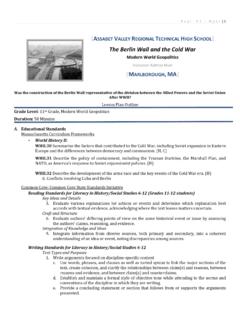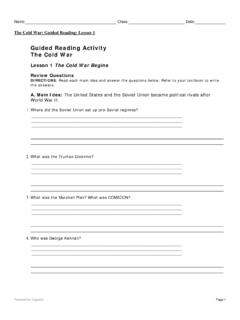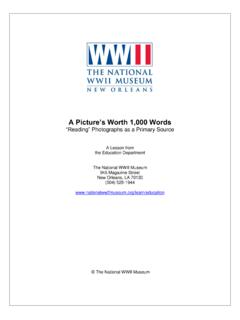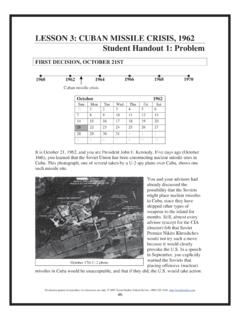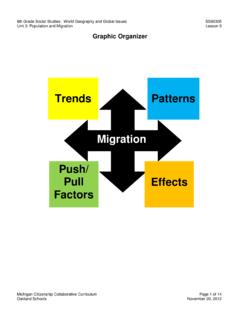Transcription of Unit 2-Lesson Plan # 3 “The Berlin Wall” - Weebly
1 lesson plan # 3. The Berlin Wall . Introduction: This lesson will introduce students to the topic of the Berlin wall. Through various stations they will experience and reflect upon the separation between East and West as symbolized literally through the construction of the Berlin Wall. The essential question is: What was the purpose of the wall, and was it effective? Objectives: Content/Knowledge: 1. Students will be able to explain the motivations of building the wall. 2. Students will be able to judge whether the wall was effective. 3. Students will be able to describe the effects of capitalism in the West and Communism in the East. Process/Skills: 1. Students will be able to draw a map or create a model of the Berlin Wall. Values/Dispositions: 1. Students will be able to sympathize with the Berliner's who lived divided throughout the years of the Berlin Wall. Standards: State Illinois Learning Standards 1. Analyze how human processes influence settlement patterns including migration and population growth.
2 National National Council for the Social Studies Standards 1. VIII. Science, Technology, and Society. Modern life as we know it would be impossible without technology and the science that supports it. But technology brings with it many questions: Is new technology always better than old? What can we learn from the past about how new technologies result in broader social change, some of which is unanticipated? How can we cope with the ever-increasing pace of change? How can we manage technology so that the greatest number of people benefit from it? How can we preserve our fundamental values and beliefs in the midst of technological change? This theme draws upon the natural and physical sciences, social sciences, and the humanities, and appears in a variety of social studies courses, including history, geography, economics, civics, and government. National National Standards for History 1. Era 9 Standard 1- How post-World War II reconstruction occurred, new international power relations took shape, and colonial empires broke up 2.
3 Era 9 Standard 2- The search for community, stability, and peace in an interdependent world Syntax Procedures 1. Logical/Mathematical: a. Teacher Instructions 1. Teacher will instruct students to read the passages and answer the questions that follow. b. Resource 1. , Logical/Mathematical readings c. Student Activity 1. Students will read the passages and answer the questions that follow. 2. Visual/Spatial: a. Teacher Instructions 1. Teacher will instruct students to analyze the maps and pictures in order to answer the questions that follow. b. Resource 1. , Maps and Pictures c. Student Activity 1. Students will analyze the maps and pictures in order to answer the questions that follow. 3. Body/Kinesthetic: a. Teacher Instructions 1. Teacher will instruct students to read the directions listed at this station. This classroom activity is designed to give students a feel for what it was like for Germans when the Berlin Wall was built.
4 B. Resource 1. , Activity instructions sheet 2. Deck of playing cards c. Student Activity 1. Students will be given cards that identify them as East German (Spades), West German (Hearts), East German Guard (Clubs), or Stasi (Diamond). They must play their part as described in a simulated divided Berlin in the classroom. 4. Musical/Rhythmic: a. Teacher Instructions 1. Teacher will instruct the students to read the pieces of poetry and answer the question or complete the activity asked underneath in bold type. b. Resource 1. , Poetry pieces c. Student Activity 1. Students will read the pieces of poetry and answer the question or complete the activity asked underneath in bold type. 5. Naturalist: a. Teacher Instructions 1. Teacher will explain the station assignment to the students, who will then go online to research the environment of the Berlin Wall. b. Resource 1. , Assignment sheet 2. Computer with internet access c. Student Activity 1.
5 Students will go online to research the environment and effects of the Berlin Wall. After research, they will draw a map or create a model of what they have discovered. 6. Interpersonal: a. Teacher Instructions 1. Teacher will instruct students to view the given picture and discuss it using the discussion starter questions. b. Resource 1. , Interpersonal handout c. Student Activity 1. Students will view the given picture and discuss it using the discussion starter questions. 7. Intrapersonal: a. Teacher Instructions 1. Teacher will direct students to read the directions on their worksheet and follow them. b. Resource 1. , Reflection worksheet c. Student Activity 1. Students will reflect on the injustices of the Berlin wall and of today and write about how steps can be taken to continue bringing freedom to the peoples of the world. 8. Verbal/Linguistic: a. Teacher Instructions 1. Teacher will instruct students to read the passage and then create a simple timeline using the dates and events given in the writing.
6 B. Resource 1. , The Berlin Wall history c. Student Activity 1. Students will read the passage and then create a simple timeline using the dates and events given in the writing. Resources (Source Citations & Bookmarks). Logical/Mathematical The Berlin Wall Background Because of dissatisfaction with the economic and political conditions (forced collectivization of agriculture, repression of private trade, supply gaps), an increasing number of people left the GDR. From January to the beginning of August 1961, about 160,000 refugees were counted. Also, the international political situation was tense. On 1958-11-27, the Soviets (Khrushchev) had delivered their Berlin ultimatum, demanding that the western allies should withdraw their troops from West Berlin and that West Berlin should become a "Free City" within six months. On 1959-02-17, the threat of settling a separate peace treaty between the USSR the GDR followed. The meeting between US President Kennedy and the Prime Minister of the USSR, Khrushchev, on 1961-06-03/04 in Vienna ended without any noticeable results.
7 Generally, measures of the government of the GDR were expected with the aim of preventing people from leaving the GDR. At an international press conference on June 15, 1961, Walter Ulbricht (the leader of the east German communist party, SED, and President of the Privy Council). answered to the question of a journalist: "I understand your question as follows: there are people in West Germany who want us to mobilize the construction workers of the GDR to build a wall. I am not aware of any such No one has the intention of constructing a wall.". What was the East German frustration? Source: #measurementsLogical/. Mathematical The Berlin Wall Construction of the Wall Early in the morning of Sunday, August 13, 1961, the GDR began under the leadership of Erich Honecker to block off East Berlin and the GDR. from West Berlin by means of barbed wire and antitank obstacles. Streets were torn up, and barricades of paving stones were erected.
8 Tanks gathered at crucial places. The subway and local railway services between East and West Berlin were interrupted. Inhabitants of East Berlin and the GDR were no longer allowed to enter West Berlin , amongst them 60,000 commuters who had worked in West Berlin so far. In the following days, construction brigades began replacing the provisional barriers by a solid wall. The reaction of the western allies was moderate, since the three essentials of the American policy regarding Berlin were not affected: presence of allied troops, free access to Berlin and the right of self- determination of the West Berliners. After 1961-08-23, citizens of West Berlin were no longer allowed to enter East Berlin . On 1961-09-20, the forced evacuation of houses situated immediately at the border to West Berlin began. On 1962-08-17, Peter Fechter, an eighteen years old citizen of East Berlin , bled to death after he was shot down by East Berlin border patrol in an attempt to escape over the wall.
9 On 1963-06-21, the Minister of National Defense of the GDR gave orders concerning the installation of a border area at the frontier between the GDR and West Berlin . Afterwards inhabitants of East Berlin living within a distance of 100 m to the border had to register. The GDR propaganda called the wall an "Anti-fascist protection wall". How did the wall come into being? Source: #measurements Logical/Mathematical The Berlin Wall Measurements The border between West Berlin and East Berlin and the GDR had a total length of 166 km, and there was a deeply staggered system of barriers. There was a wall with a length of 107 km at this border. Finally, the border area looked about as follows: First, there was a wall which was made up of concrete segments with a height of 4 m, usually with a concrete tube on top of it. Behind it (at the "eastern" side) there was an illuminated control area (also called death area). Refugees who had reached that area were shot without warning.
10 A trench followed which should prevent vehicles from breaking through. Then there was a patrol track, a corridor with watchdogs, watchtowers and bunkers, and a second wall. The border cut through 192 streets, 97 of them leading to East Berlin and 95 into the GDR. At least 100 people were killed at the Berlin Wall, the last of them was Chris Gueffroy (1989-02-06). Convert the metric measurements in to English system. How long was the Berlin wall in miles? Source: #measurements Logical/Mathematical The Berlin Wall Fall In the year 1989, there were dramatic events such as a massive flight of inhabitants of the GDR via Hungary and big demonstrations in Leipzig on Mondays. After weeks of discussion about a new travel law, the leader of East Berlin 's communist party (SED), G nter Schabowski, said on November 9, 1989 at about 7 in somewhat unclear words that the border would be opened for "private trips abroad". Little later, an onrush of East Berliner's towards West Berlin began, and there were celebrations at the Brandenburg Gate and at the Kurf rstendamm in West Berlin .
